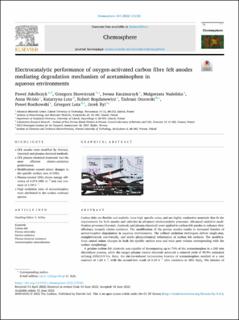| dc.contributor.author | Jakobczyk, Pawel | |
| dc.contributor.author | Skowierzak, Grzegorz | |
| dc.contributor.author | Kaczmarzyk, Iwona | |
| dc.contributor.author | Nadolska, Malgorzata | |
| dc.contributor.author | Rostkowski, Pawel Marian | |
| dc.date.accessioned | 2022-07-04T08:50:36Z | |
| dc.date.available | 2022-07-04T08:50:36Z | |
| dc.date.created | 2022-06-20T12:18:19Z | |
| dc.date.issued | 2022 | |
| dc.identifier.citation | Chemosphere. 2022, 304, 135381. | en_US |
| dc.identifier.issn | 0045-6535 | |
| dc.identifier.uri | https://hdl.handle.net/11250/3002534 | |
| dc.description.abstract | Carbon felts are flexible and scalable, have high specific areas, and are highly conductive materials that fit the requirements for both anodes and cathodes in advanced electrocatalytic processes. Advanced oxidative modification processes (thermal, chemical, and plasma-chemical) were applied to carbon felt anodes to enhance their efficiency towards electro-oxidation. The modification of the porous anodes results in increased kinetics of acetaminophen degradation in aqueous environments. The utilised oxidation techniques deliver single-step, straightforward, eco-friendly, and stable physiochemical reformation of carbon felt surfaces. The modifications caused minor changes in both the specific surface area and total pore volume corresponding with the surface morphology. A pristine carbon felt electrode was capable of decomposing up to 70% of the acetaminophen in a 240 min electrolysis process, while the oxygen-plasma treated electrode achieved a removal yield of 99.9% estimated utilising HPLC-UV-Vis. Here, the electro-induced incineration kinetics of acetaminophen resulted in a rate constant of 1.54 h−1, with the second-best result of 0.59 h−1 after oxidation in 30% H2O2. The kinetics of acetaminophen removal was synergistically studied by spectroscopic and electrochemical techniques, revealing various reaction pathways attributed to the formation of intermediate compounds such as p-aminophenol and others. The enhancement of the electrochemical oxidation rates towards acetaminophen was attributed to the appearance of surface carbonyl species. Our results indicate that the best-performing plasma-chemical treated CFE follows a heterogeneous mechanism with only approx. 40% removal due to direct electro-oxidation. The degradation mechanism of acetaminophen at the treated carbon felt anodes was proposed based on the detected intermediate products. Estimation of the cost-effectiveness of removal processes, in terms of energy consumption, was also elaborated. Although the study was focussed on acetaminophen, the achieved results could be adapted to also process emerging, hazardous pollutant groups such as anti-inflammatory pharmaceuticals. | en_US |
| dc.description.abstract | Electrocatalytic performance of oxygen-activated carbon fibre felt anodes mediating degradation mechanism of acetaminophen in aqueous environments | en_US |
| dc.language.iso | eng | en_US |
| dc.rights | Navngivelse 4.0 Internasjonal | * |
| dc.rights.uri | http://creativecommons.org/licenses/by/4.0/deed.no | * |
| dc.title | Electrocatalytic performance of oxygen-activated carbon fibre felt anodes mediating degradation mechanism of acetaminophen in aqueous environments | en_US |
| dc.title.alternative | Electrocatalytic performance of oxygen-activated carbon fibre felt anodes mediating degradation mechanism of acetaminophen in aqueous environments | en_US |
| dc.type | Peer reviewed | en_US |
| dc.type | Journal article | en_US |
| dc.description.version | publishedVersion | en_US |
| dc.rights.holder | © 2022 The Authors. Published by Elsevier Ltd. | en_US |
| dc.source.volume | 304 | en_US |
| dc.source.journal | Chemosphere | en_US |
| dc.identifier.doi | 10.1016/j.chemosphere.2022.135381 | |
| dc.identifier.cristin | 2033389 | |
| dc.relation.project | NILU - Norsk institutt for luftforskning: 120133 | en_US |
| dc.source.articlenumber | 135381 | en_US |
| cristin.ispublished | true | |
| cristin.fulltext | original | |
| cristin.qualitycode | 1 | |

